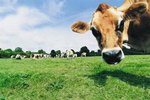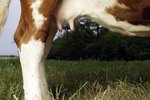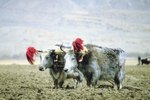That funny looking cow over there -- that is a Brahman bull. It looks a little dopey with its big hump, saggy skin and droopy ears, but don't be fooled. That bull is as hearty as they come. The calves he'll sire will be able to stand the heat.
Here's Looking at You
It's not hard to spot Brahman cattle. You'll know them by the large humps on their shoulders and necks. Another clue is their big floppy ears, which is a trait shared by most, but not all, Brahman cattle, though. If you get closer, you might be able to smell Brahman cattle. They have more active sweat glands and also produce an oily secretion that helps repel insects. Males have horns that usually curve upward, if not backward. (They're also obviously male, to the extent you can see their genitals.) These animals are medium-sized relative to other common cattle breeds, although they're among the hardiest of the hardy.
Out of India
Although often associated with Texas, Brahman cattle originally are of Indian stock. Specifically, they're related to Bos indicus. It's likely the breed began more than 4,000 years ago, according to the Texas State Historical Association. Quite literally sacred cows, these cattle never were used for meat, although harsh environmental conditions forced them to develop the traits that help distinguish them from other cattle. Their loose, black skin, for instance, stops intense sun, while their short, thick, glossy coat reflects it. These traits were refined further through breeding once Brahman cattle were established in the United States.
In the U.S.
In the late 19th and early 20th centuries, ranchers imported a few proto-Brahman bulls to the southern United States. This had been verboten, but sanctions and quarantines slowly waned. These bulls were bred with European cattle and, over time, American Brahman cattle emerged. Specifically, three of India's approximately 30 cattle breeds were instrumental: the Guzerat, the Nellore and the Gir, according to Oklahoma State University, as well as a dab of the Krishna Valley strain. The intention was to breed cattle who could withstand harsh climate and humidity. While cattle of European stock suffer when temperatures get into the 70s, Brahman cattle thrive at temperatures upward of 100 degrees, according to University of Missouri research.
Bully to You
There are lots of sex- and age-specific terms for male and female cattle. Some obvious distinctions are bulls and steers alongside cows and heifers. Bulls are in-tact males; steers are their castrated compatriots. Bulls can impregnate cattle of other breeds, which is how the Brahman breed got started. Steers usually are castrated before reaching sexual maturity, so it's uncommon to turn a bull into a steer, as his sexual maturity carries its own hormonal baggage.
References
Resources




